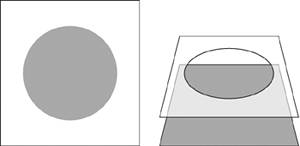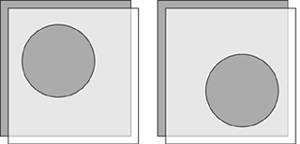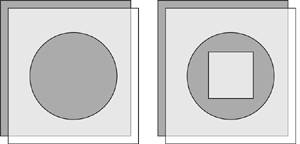Understanding Shapes
| In Photoshop Elements, you create shapes not by rendering them with pixels, but by constructing them from vector paths. In Photoshop Elements, those vector paths are actually vector masks. We'll use some simple circle and square shapes to illustrate what that means. Each time you draw a shape with one of the shape tools, Photoshop Elements is performing a little behind-the-scenes sleight of hand. Although it may appear that you're drawing a solid, filled circle, for instance, what you're really creating is a new layer containing both a colored fill and a mask with a circle-shaped cutout (Figure 8.85). When you move, reshape, or resize a shape, you're actually just moving or reshaping the cutout and revealing a different area of the colored fill below it (Figure 8.86). When you add to or subtract from a shape by drawing additional shapes, you're simply revealing or hiding more of the same colored layer (Figure 8.87). Figure 8.85. When you draw a shape, you're actually drawing a shape mask.
Figure 8.86. Moving a circle shape really means moving the circle cutout portion of the mask.
Figure 8.87. Adding a shape to a layer masks off another portion of the colored fill below it, in this case giving the illusion that the circle has a square hole in its center.
Every time you create a new shape, a new shape layer is added to the Layers palette. A shape layer is represented in the palette thumbnails by a gray background (the mask) and a white shape (the mask cutout, or path). Since a shape's outline isn't always visible in the image windowif you deselect it, for instancethe Layers palette provides a handy, visual reference for every shape in your project (Figure 8.88). And as with any other layered image, you can use the Layers palette to hide a shape's visibility and even change its opacity and its blending mode. Figure 8.88. Every shape or combination of shapes appears on its own layer on the Layers palette.
|
EAN: 2147483647
Pages: 178



